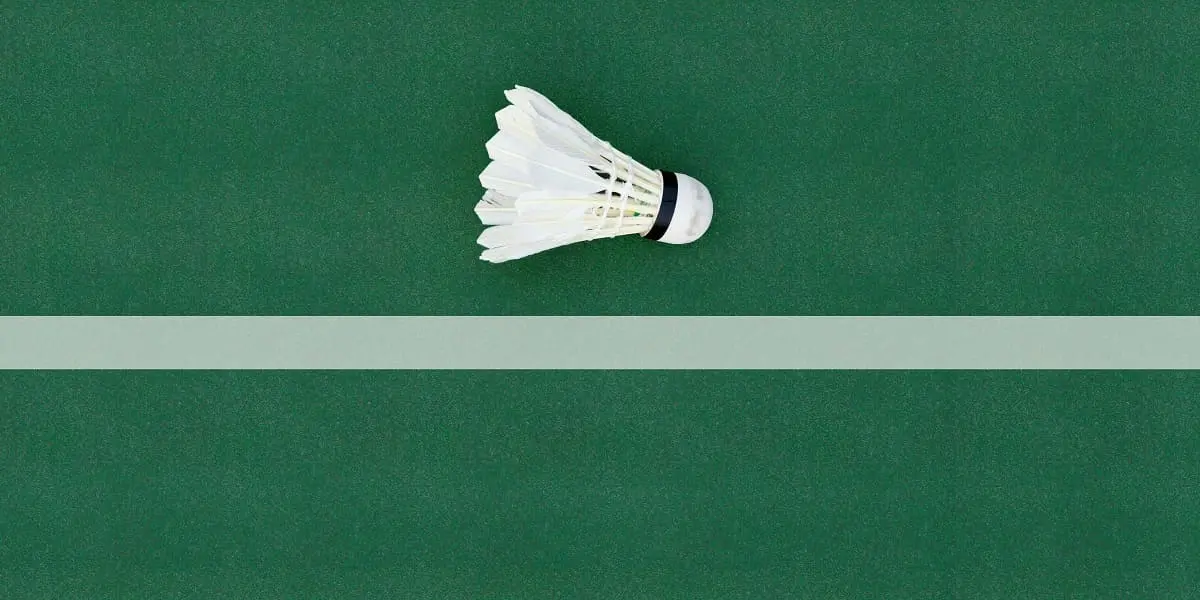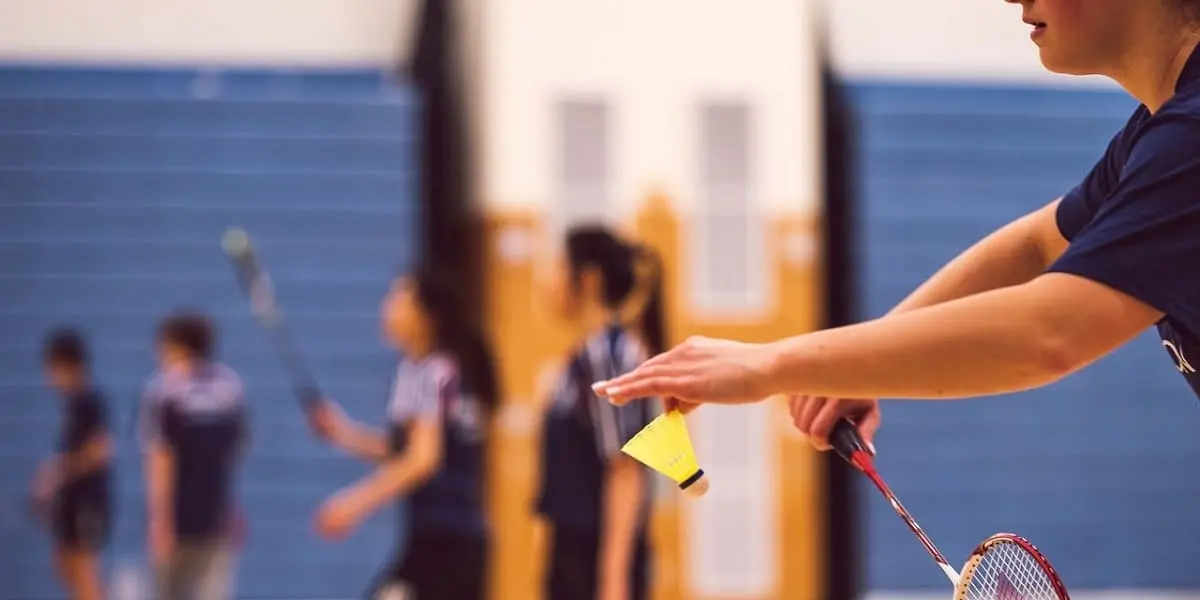Content
Definition: What is badminton?
Badminton, an Olympic sport since 1992, is played individually or in doubles in five events: men’s and women’s singles, men’s and women’s doubles and mixed.
The game consists of exchanging shuttlecocks over a net, with the aim of scoring points by landing the shuttlecock in the opponent’s court. Extremely popular, especially in Asia, this sport is played by millions of enthusiasts.

What are the rules of badminton?
Court and dimensions
A badminton court is a rectangle 13.40 meters long. The width of the court is 6.10 meters for doubles matches and 5.18 meters for singles matches.
The surface is divided in two by a central net 1.55 meters high. Each half is marked by service lines, as well as by side and back lines, which define the playing areas specific to each format.
The court must be flat, smooth and non-slip to allow play.
The service
In badminton, the match begins with the serve, the first stroke of the shuttlecock that starts the rally. The server throws the shuttlecock diagonally into the opponent’s court, sending it upwards with his racket.
This shot must be made below the height of the player serving, and the shuttlecock must cross the net without touching it before falling back into the defined service area.
If the server wins a rally, he scores a point. The server must then serve again from the other service area. If the receiving side wins a rally, it scores a point. The receiving side becomes the new server side.
Points and games
In a badminton match, the aim is to win two sets out of three, with each set played to 21 points. The team that wins a rally scores a point.
In the event of a tie at 20 points, the set continues until one team takes a two-point lead or reaches the 30-point threshold.
The team that won the previous set has the right to serve first in the next set.
Fouls and penalties
Various actions can constitute badminton fouls. For example, if the shuttlecock lands outside the court boundaries, if it passes under the net or does not cross it, if it touches a player or his clothing, if it is hit consecutively by the same player or his teammate, or if a player performs an incorrect serve.
A player may also be penalized if he comes into contact with the net or posts with his racket, body or clothing, if he enters the opponent’s court above the net, or if he intentionally hinders or distracts his opponent.
Each of these errors results in the loss of the point or service in progress.
Singles and doubles matches
Badminton, an easily accessible sport, offers two versions of the game: singles and doubles.
In singles, two players compete on a small court. This configuration calls for physical play and fine-tuned strategy, forcing players to manage the whole court and diversify their shots.
Doubles matches, on the other hand, bring together four players on a larger court. These matches are characterized by an accelerated pace and a pronounced technical dimension, forcing players to synchronize their movements and give priority to attacking.
Beyond its apparent simplicity, badminton demands sustained attention, great precision and an excellent ability to react.
Tips and strategies to excel at badminton
Positioning and movement
Badminton demands great mobility and the ability to anticipate movements. Strategic positioning on the court is essential: you need to cover as much space as possible while being ready to attack or defend.
Efficient movement is also essential: master chassé steps, cross movements and jumps. Avoid staying too close to the net or moving too far back.
In doubles, keep a safe distance from your partner to avoid collisions.
Strategic shots: smash, drop and drive
Diversification of shots is essential in badminton to disrupt your opponent.
The smash, hit from above with speed and precision, is designed to finish the point. The drop, more subtle, slows play by dropping the shuttlecock just behind the net. As for the drive, this taut, direct stroke speeds up play.
Mastering these offensive techniques will give you a definite tactical advantage.
Service tips to surprise your opponent
Mastery of the serve, that essential first shot, is fundamental: vary it to gain the advantage from the start.
The short serve is designed to limit your opponent’s smash possibilities, while the long serve pushes him back inside the court. To surprise your opponent, opt for a taut, low and fast serve.
Each serve has its own technique: use the spoon movement for the short serve, the upward movement for the long serve and the horizontal movement for the tight serve.
Endurance and mental management
Good physical condition and mental stamina are essential in badminton, a sport where exchanges can be long and exhausting.
Learn to manage your breathing, maintain an adequate rhythm and control your emotions. Take breaks if necessary, hydrate regularly and stay calm, focused and confident, without being distracted by others or opponents.
Training tips and practical exercises
To progress in badminton and refine your technique, regular, well-targeted training is essential. We recommend at least two sessions a week, combining group and solo training.
All the key elements of the game deserve special attention: movements, racket strokes, service and strategy need to be worked on rigorously. Here are a few useful exercises:
- Shadowing: this exercise involves imitating movements and strokes without using a shuttlecock or facing an opponent. It’s an excellent way to perfect technique and coordination;
- Multi-shuttlecock: this involves receiving a series of shuttlecocks from a teammate or an automatic device, directed at different areas of the court. This improves players’ reactivity and precision;
- Free play: playing friendly or competitive matches with opponents of different skill levels is an excellent way to refine your playing strategy.
How to choose the right badminton equipment?
How to choose the right racket?
The key to a successful badminton experience lies in choosing the right racket for you. This choice varies according to your level of play, your style and your physical condition.
Key factors to consider are weight, balance, stiffness and racket head shape. Here’s some practical advice:
- Beginners: Choose a lightweight snowshoe (80-90 g) with a neutral balance (28-30 cm) and flexibility that favours manoeuvrability and comfort;
- Intermediates: Opt for an intermediate-weight racket (90-95 g), with a slightly airy balance (30-32 cm) and semi-rigidity, for power and versatility;
- Experts: A heavier racket (95-100 g), with a pronounced balance towards the head (32-34 cm) and increased rigidity will guarantee speed and responsiveness.
Feather or synthetic shuttlecocks?
Feather and synthetic shuttlecocks are indispensable for badminton. They differ in terms of cost, durability and performance:
- Feather shuttlecocks: more expensive and more fragile, but offering precision and stability, they are preferred by experienced players for their better playing feel;
- Plastic shuttlecocks: Less expensive and more resistant, but less precise, they are suitable for occasional or beginner players thanks to their durability and solidity.
Which badminton shoes should I choose?
Badminton shoes need to protect your feet and support your joints. A good pair offers support and grip:
- Support: Choose well-fitting shoes that support the ankle and heel, and offer quality cushioning to prevent injury;
- Grip: your shoes should be designed for the type of playing surface, with a light, grippy sole for optimum mobility.
What badminton clothing and accessories to choose?
Your clothing and accessories should enhance your comfort and performance on the court.
When making your choice, opt for lightweight, breathable outfits, ideally made from synthetic materials that dry quickly and resist moisture.
Choose useful accessories such as an equipment bag, an over-grip for a better grip, sweatbands and goggles.
- Discover also
- All you need to know about Rowing
